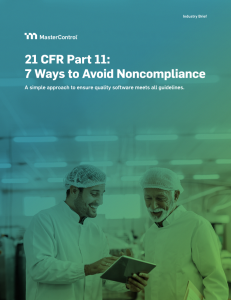
5 CAPA Innovations for
Continuous Improvement
Discover the Value of Data-Driven CAPA Management
Corrective actions/preventive actions (CAPAs) are reserved for quality events that occur with high frequency or have a big impact. These actions are one of the most critical tools that quality professionals use to keep their quality management systems (QMS) and the processes that constitute them in control. Although CAPAs are essential control mechanisms, the majority of quality organizations continue to struggle to adequately standardize their CAPA processes and/or document the evidence of their compliance with these processes.
The need for efficient and verifiable CAPA processes is a pressing concern. But the traditional way that quality professionals have tried to handle them is clearly not working. Part of this is due to the complex and subjective nature of quality event management (QEM). It depends heavily on the skills and experience of quality professionals. However, they are limited by fixed processes that dictate their efforts and prevent them from infusing their expertise into QEM activities.
A modern approach to quality event management requires that quality organizations align with the tenets of Quality 4.0, namely digitization, automation, and integration, to get a technological grip on the problems that continue to plague them. By embracing emergent intelligent platform solutions, quality personnel will be able to move beyond the acute and reactive nature of individual quality events and shift into the new paradigm of predictive and prescriptive data-driven quality management that better enables continuous improvement.
The FDA reports that since 2018, a “lack of or inadequate CAPA procedures” has consistently been found in 20–25% of all annual observations. An additional 5–8% come due to failure to document CAPA activities.
Ongoing Challenges With Traditional CAPA Software Solutions
Unfortunately, quality professionals face ongoing challenges with inadequate quality event management solutions even if they invest in digital ones. A fatal error that organizations make is to invest in solutions without understanding how well they meet the particular business needs of their industry or company. On top of that, many software applications remain disconnected from other essential systems.
Many of them lack personalization capabilities. This prevents quality professionals from designing custom processes and incorporating verifiable data into their records, both of which they need to manage quality events with precision and preserve their CAPA system.
In general, the more variable and situation-based a process is, the less often it is fully digitalized.
Most CAPA software offerings compel quality professionals to adapt their processes to match the software application and negatively impact continuous improvement efforts in the following ways:
-
Limited Configurability
Configurability can simply be defined as the ratio of system variation to user input effort. Many CAPA software solutions claim to offer customization, however most entail alterations at a deeply encoded level that come with the additional expense and delay of services from the software vendor or a qualified third party.
-
Limited Data Capture
At the core of CAPA management is the ability to effectively identify and eliminate root causes. However, it is difficult to accomplish this priority without substantial data points. Further, effective containment and resolution steps need to be tailored to the determined cause. Limited data restricts tracking and trending capabilities that can enable continuous improvement.

-
Rigid Processes
Configurability can simply be defined as the ratio of system variation to user input effort. Many CAPA software solutions claim to offer customization, however most entail alterations at a deeply encoded level that come with the additional expense and delay of services from the software vendor or a qualified third party.

-
Complexity for Users
The skills of investigating root causes, analysis, and coming up with effective corrections are difficult to train on. A software solution that is disconnected from other quality functions, is difficult to use, or lacks an intuitive user interface only compounds the complexity of quality event management.
-
Difficult Set Up and Management
Typically, implementing a robust quality event management process and linking it to related forms, data, and personnel requires extensive IT expertise and can take weeks to implement. This precludes the possibility of quality professionals revisiting and modifying processes within the software application – even though processes are necessarily evolving in day-to-day operations.
-
Long Process Improvement Cycles
To replace old ways of doing things with new ones requires review and approval cycles, as well as some uphill adoption efforts – all of which can take considerable time. It doesn’t make sense to add coding requirements to an already extensive timeline – or to take the responsibility of CAPA process iterations outside of the quality function in the first place. The potential for delays and defects just increases.
Converting CAPAs Into Business Value
It’s important to look back on past problems so you can avoid repeating them, but learning from the past and getting stuck in the past are two very different experiences. The CAPA management software you choose can determine which experience you will have. QEM processes and policies that are only reactive in nature make it impossible to move into the preventive paradigm.
When you are not bogged down with acute QEM concerns and CAPA overwhelm, you have room to see what’s missing and time to focus on the future. You can discover opportunities for improvement and leverage your new solution to your advantage.
Essential questions to answer when you are considering CAPA software solutions are:
-
What am I trying to accomplish with my quality event management processes and tools?
-
Do I want to just focus on quality problems, or do I want connected tools to iteratively improve the quality management system overall?
-
How can I use a QEM software solution to redirect, mobilize, and optimize resources in a timely way?
-
How can software help me maintain controlled operations when events occur and corrections and changes are necessary?
-
What features allow me to leverage and scale the ingenuity of my quality function rather than stifle it?
-
How much cross-functional visibility does the solution offer to enable varied perspectives to join together to create something unique and innovative?
A culture of quality requires employees to apply skills and make decisions in highly ambiguous but critical areas while leading them toward deeper reflection about the risks and payoffs of their actions. In an environment where customers’ tolerance for quality problems is declining, a workforce that embraces quality as a core value is a significant competitive advantage.
Advanced Process Capabilities Within MasterControl Quality Excellence
By choosing innovative CAPA management tools, you can promote innovation across your quality organization. QMS software equipped with advanced process capabilities permits authorized users to make iterative process improvements within minutes to streamline quality event management. Users can pull additional data into these processes when needed. These innovations make it possible for quality professionals to both manage quality events with precision and make deliberate moves closer to a state of continuous improvement.
Many positive cultural shifts coincide with this level of empowerment:
-
Problems can be identified and resolved earlier in product life cycles.
-
Process iteration and improvement is possible without expensive outsourcing.
-
Professional expertise can be infused into quality processes.
-
Shared visibility into processes, personnel, and data fosters ownership and accountability.
-
Robust risk assessment and management can be built into processes.
5 Innovations You Can’t Ignore
MasterControl’s advanced Quality Event Management (AQEM) within the Quality Excellence solution supports the following innovative approaches to CAPA management:
-
Customization
Highly configurable workflow and form builders make it possible for the professionals themselves to design effective processes and data captures. AQEM offers multiple layers of customization, including workflows, steps, forms, and data fields. Processes can be recalibrated over time to meet the evolving needs of a quality organization without requiring the added expense and assistance of IT services.
There are many facets to a quality event. Being able to investigate them in a flexible environment like AQEM, while maintaining closed-loop quality event management, will help further streamline our workflows.
-
Data-Driven Processes
Without requiring any IT know-how, AQEM allows quality professionals to enrich their processes with data captures surrounding quality events and make their data actionable within minutes by iterating processes. Depending on what data users subsequently enter on a particular form, the system can dynamically initiate conditional routing or launch related processes and forms based on rules established by system administrators. Consequently, multiple scenarios can be managed using a single form.
This idea of purpose-built, no-code solutions I think is core to where the future is headed—data at the heart of everything.”
-
Resource Optimization
AQEM is designed around roles and rights that individual users are granted as part of user groups. Based on various attributes, users can access locations and personalized task lists congruent with – and only with – their permissions and responsibilities. It is no longer necessary for users to wade through irrelevant processes, forms, and steps. And it is no longer necessary to introduce possible oversight as a result. When it’s desirable, multiple users can collaborate on the same form.
-
Connected Compliance
A unified QMS can automatically route documentation, reviews, approvals, escalations, training tasks, related processes, and so on – which are all searchable across a single platform. All stakeholders have visibility into all processes all the time – even remotely via the cloud. Connecting appropriate personnel with system data empowers them to make improvements, and they are more inspired to do so when the evidence to justify them is apparent.
-
Intelligent Capabilities
AQEM is built on a data-first platform to set the stage for intelligence. Intelligent tools will enable the predictive and prescriptive model that will characterize quality event management in the future. Tagged data makes it possible to keep data tracking in place even when processes change. Ultimately, it can be used to establish the training data sets necessary for machine learning so that the QMS truly reflects the hard-earned intelligence of the professionals who administer it.
Conclusion
It goes without saying that continuous improvement has no end. Further, it can feel like a lost cause without buy-in spanning across an organization. When you consider the scope of this endeavor, it can be overwhelming. A strategic way to approach continuous improvement is to take advantage of the critical moments afforded by any CAPAs or quality events that inevitably occur. The resources and attention that these problems demand can be leveraged to simultaneously address ongoing improvement objectives.
Empowering quality personnel with user-friendly, configurable software solutions that can pull solid, up-to-date data gives them a mechanism to build, test, and improve their own processes without needing technical assistance. The professional can ensure the right processes are in place at the right time and that they’re linked to other essential processes. In this way, both insight and power belong to the subject matter expert – which is exactly where they should be.

